| Type | Description | Contributor | Date |
|---|---|---|---|
| Post created | Pocketful Team | Oct-06-24 |
5 Must-Read Best Swing Trading Books for Trader
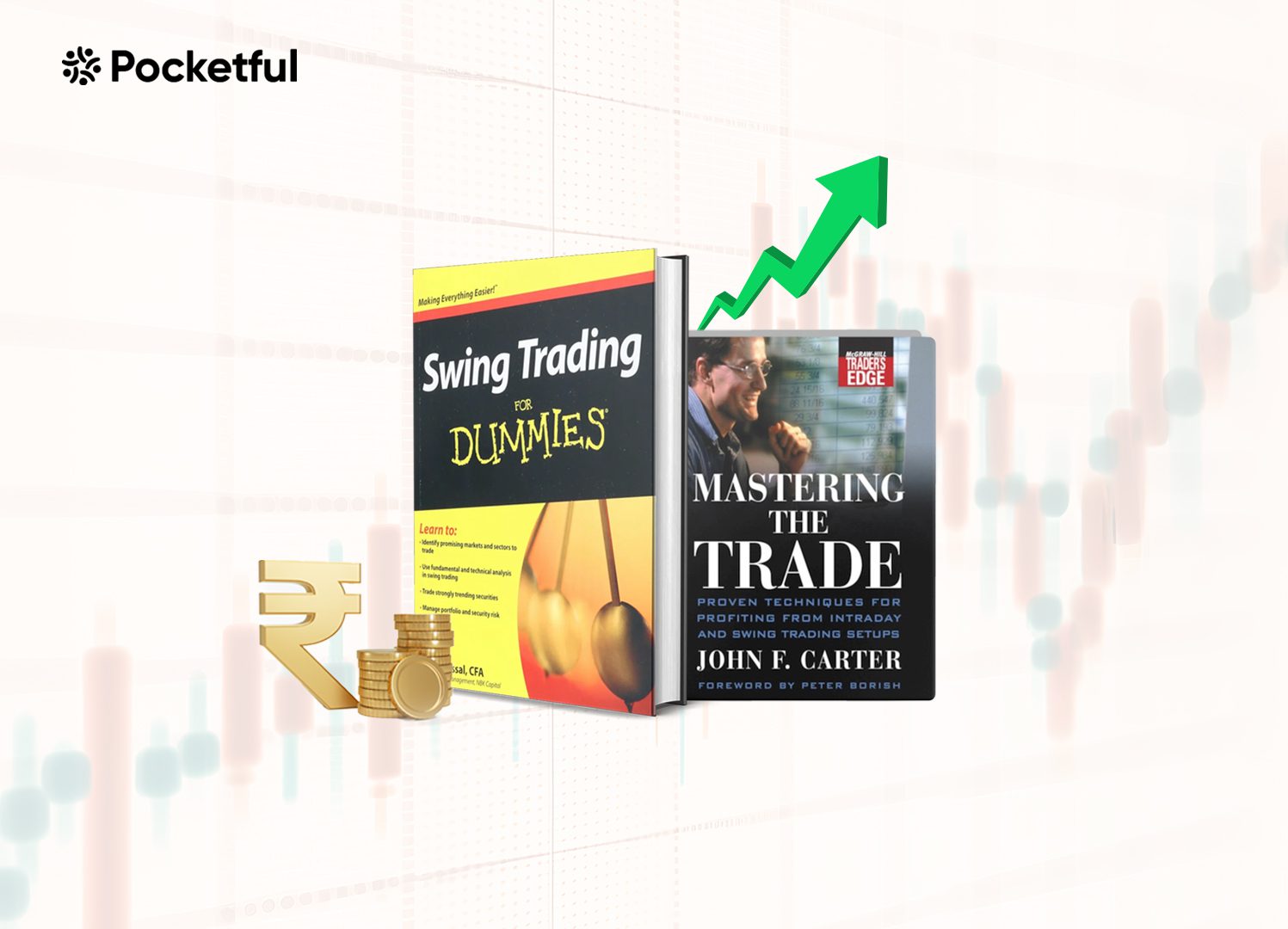
Swing Trading is all about catching the short and medium-term trend and riding the swing to earn profits from it. Swing trading is a widespread trading strategy that involves holding positions for a few days to a few weeks to profit from short- to medium-term price movements. Swing trading is different from day trading because an individual doesn’t need to monitor the trade constantly and can still take advantage of short-term mispricing. In swing trading, traders can profit from both bullish and bearish movements.
Swing trading is all about quick decision-making, well-defined strategy, and disciplined execution. Through this, we can take advantage of price swings while managing risk effectively. In this blog, we will discuss swing trading and its key concepts and share a list of the best books that an individual can read to learn swing trading.
What is Swing Trading?
Swing trading is a common trading strategy that focuses on catching short- to medium-term price movements in financial markets. In swing trading, the holding period can range from several days to a few weeks. It is different from day trading, where positions are opened and closed within the same day. Swing trading allows more flexibility with timeframes (from short to medium term), which enables the traders to profit from price fluctuations or swings over an extended period of time.
List of Best Swing Trading Books with an Overview
If someone is looking to deepen their understanding of swing trading, then here are some highly recommended best swing trading books that can provide valuable insights into various aspects of trading and risk management strategies:
| S.No. | Book Name | Year | Name of the Author | Rating (Goodreads) |
|---|---|---|---|---|
| 1 | How to Swing Trade | 2018 | Brian Pezim | 4.21 |
| 2 | How to Make Money in Stocks | 1988 | William J. O’Neil | 4.05 |
| 3 | Mastering the Trade | 2005 | John F. Carter | 3.99 |
| 4 | Swing Trading for Dummies | 2019 | Omar Bassal | 3.95 |
| 5 | The Master Swing Trader | 2000 | Alan S. Farley | 3.26 |
1. “How to Swing Trade” by Brian Pezim and Andrew Aziz
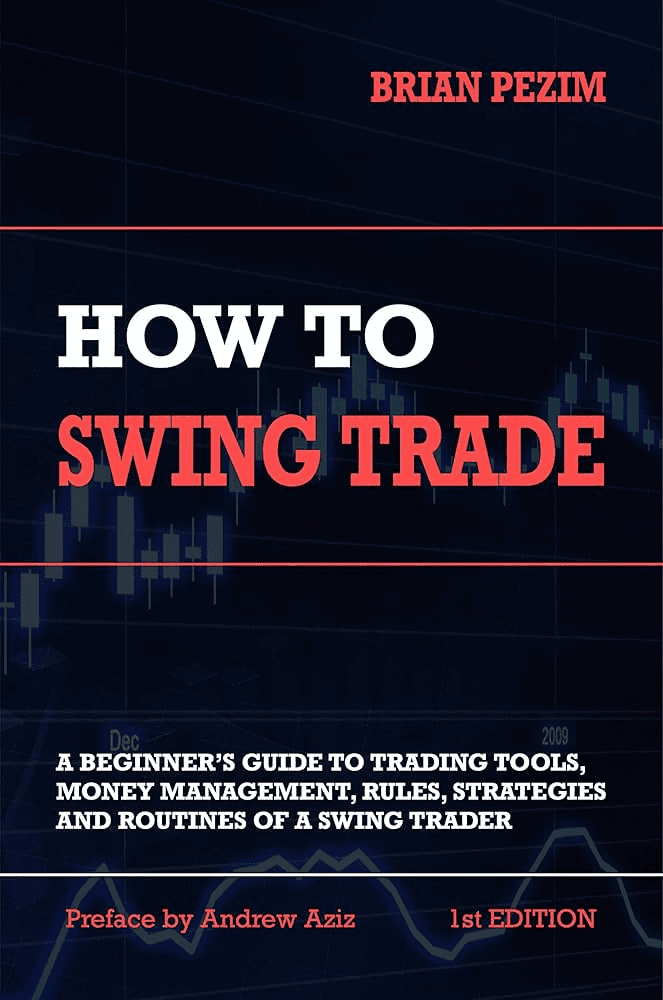
“How to Swing Trade” is a useful guide designed to help traders understand and execute effective swing trading strategies. It is written by expert traders Brian Pezim and Andrew Aziz. The book provides a comprehensive approach to swing trading, focusing on technical analysis, trade setups, and risk management.
Why It Is Great: It provides a clear framework for swing trading for both beginners and experienced traders. It focuses on technical analysis, which is very important in swing trading. It explains when to enter and exit the trade with real-world examples and emphasizes on trading psychology.
These swing trading books provide a solid foundation for beginners looking to develop their swing trading skills and for experienced traders to sharpen their skills, covering both theoretical and practical aspects of trading.
2. “How to Make Money in Stocks” by William J. O’Neil
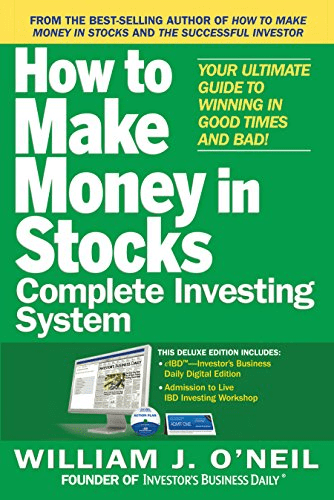
“How to Make Money in Stocks” is a comprehensive investment guide that covers both fundamental and technical aspects of the trade. It introduces readers to the CAN SLIM strategy developed by William J. O’Neil, a successful investor and founder of Investor’s Business Daily. The book focuses on a systematic approach to identifying and investing in winning stocks by combining both fundamental and technical analysis, focusing on growth stocks and timing the trade, which is essential for swing trading.
Why It Is Great: It combines both fundamental and technical analysis and introduces the CAN SLIM strategy, which stands for Current quarterly earnings, Annual earnings, New products, Supply and demand, Leaders or laggards, Institutional ownership, and Market direction. This framework helps investors identify stocks with strong growth potential. This swing trading book also emphasizes technical analysis to recognize patterns to enter and exit trades effectively.
3. “Mastering the Trade” by John F. Carter
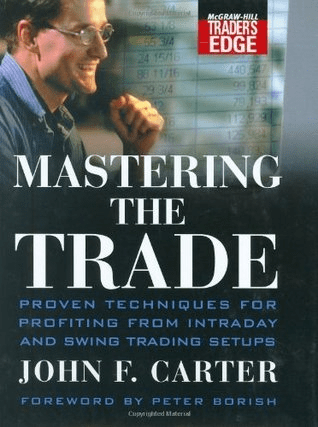
“Mastering the Trade” is a comprehensive guide for trading that combines technical analysis, risk management, and other practical insights to help traders succeed in different market conditions. It was written by an expert trader named John F. Carter. The book covers key topics such as identifying trade setups, executing trades, and maintaining discipline. Carter shares practical strategies and real-life examples, making complex concepts easy to understand for both beginner and experienced traders.
Why It Is Great: The book’s comprehensive approach covers all aspects of trading, right from technical analysis to risk management, to provide a well-rounded perspective. It also offers practical strategies and setups that traders can incorporate into their trading practices. It also includes case studies and real-life examples, with a focus on risk management and how to develop discipline and emotional resilience for success.
4. “Swing Trading for Dummies” by Omar Bassal
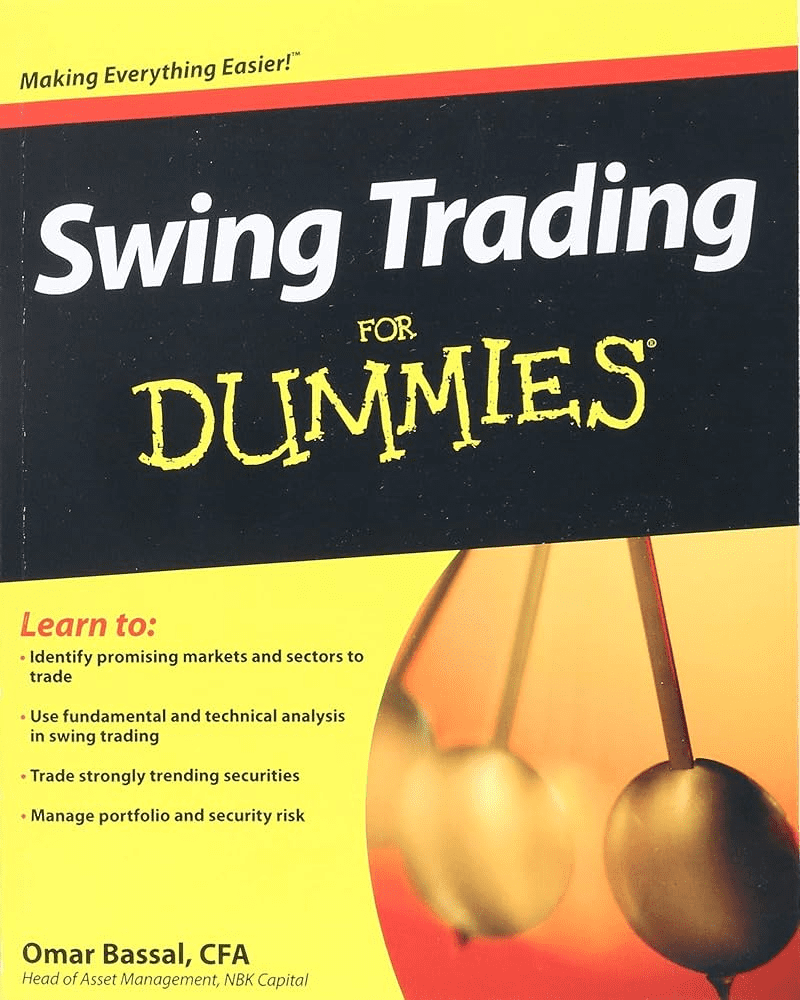
“Swing Trading for Dummies” is a handy guide designed for both beginners and intermediate traders looking to understand swing trading strategies. It is written by Omar Bassal, a financial analyst and educator. This book is a practical resource for swing trading as it simplifies the principles of swing trading, focusing on how to capture short- to medium-term market moves. It covers all the essential topics, such as technical analysis, chart patterns, entry and exit strategies, and risk management.
Why It Is Great: The book is written in a straightforward language and has clear explanations, which makes this swing trading book easy to understand for everyone. It provides a structured approach with detailed instructions on identifying trends and how to use that information. It also focuses on technical analysis and risk management strategies.
5. “The Master Swing Trader” by Alan S. Farley
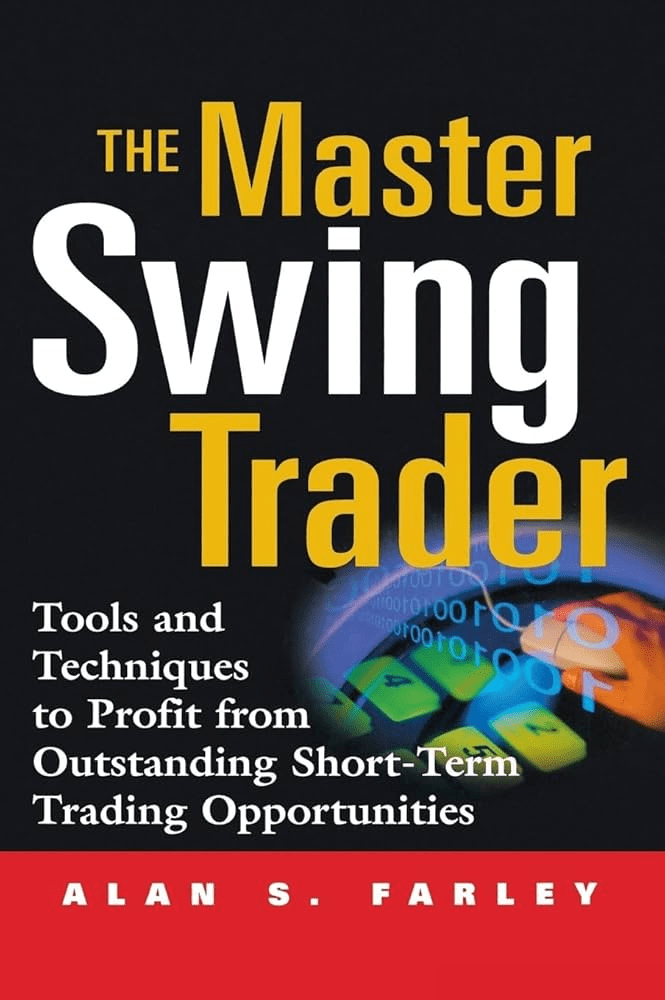
“The Master Swing Trader” is a complete guide that dives deep into the art and science of swing trading. It is written by Alan S. Farley, an expert trader and educator. This book offers an abundance of knowledge on identifying profitable trading opportunities and how to execute such trades in a disciplined way. Alan combines technical analysis, psychology, and different trading strategies to provide readers with a solid framework to succeed in swing trading. The book is structured in a way to help traders navigate through various market conditions and equips them with the necessary tools to navigate the complexities of the financial markets.
Why It Is Great: It provides an in-depth analysis of technical analysis and various chart patterns. Strategies discussed include entry-exit, stop-loss, and risk management techniques. It covers psychological aspects, which are crucial for mental clarity and effective decision-making. The book presents practical examples so that it is understood by beginners as well as experienced traders.
Key Concepts of Swing Trading
The key concepts of swing trading are as follows:
Fundamental Analysis: Fundamental analysis is an optional tool that few swing traders consider to improve their trades.
Steps in Swing Trading
Objective: Swing traders aim to profit from both upward and downward price movements in the market.
Holding Period: The holding period could vary between a few days to weeks, which sets it apart from very short-term day trading (minutes to hours) and long-term investing (months to years).
Market Analysis:
+Technical Analysis: Swing traders primarily use technical analysis tools, such as chart patterns, candlestick patterns, and indicators like moving averages, the Relative Strength Index (RSI), MACD, and Fibonacci retracements, etc.
Like any other trading strategy, swing trading needs technical knowledge, emotional control, and risk management. These are the steps involved in swing trading:
- Identify Trends: Finding the direction of a trend is always important when deciding whether one should create a long position or a short position.
- Choose an Entry Point: Swing traders look for small price pullbacks in uptrends or small rallies in downtrends to make positions at more favorable levels.
- Manage Risk: Effective swing trading strategy involves clear stop-loss and targets before entering the trade.
- Exit Strategy: Traders can book profits when the price reaches resistance or support levels, or key technical indicators show a reversal is likely.
Advantages of the Swing Trading
The advantages of swing trading are:
- It’s one of the popular trading strategies.
- It’s very flexible and doesn’t need much time commitment.
- It doesn’t require constant monitoring.
- An individual can use swing trading strategies to benefit from short- and medium-term price movements.
- Swing trades benefit from volatile markets, as volatility creates frequent price swings which creates more opportunities to profit.
- Swing trading strategies can be customized to create a balanced risk and reward ratio.
- It is less stressful than day trading.
- It can be automated.
- It works in any market, such as equity, currency, and commodity markets.
- It works on short- and medium-term time frames, but a higher time frame suggests a strong price movement is expected.
Limitations of the Swing Trading
The limitations of swing trading are:
- Swing trading strategies can fail like any other strategy, which can result in losses.
- Swing traders face market risk as they hold positions overnight, and adverse news can result in price gaps.
- Swing trading requires expertise in technical analysis as it requires a deep understanding of patterns, trends, indicators, etc.
- Swing trading strategies can be affected by various market factors, such as volatility, news, policy change, political instability, etc.
- Due to focus on short to mid-term mispricing, traders can miss a long-term investment trend.
- Swing trading strategies can result in losses in the sideways market.
Conclusion
Swing trading offers a dynamic, flexible, and balanced approach between day trading and long-term investing. Swing trading strategies aim to profit from short to medium-term price movements over several days or weeks without constant monitoring of the trades. To become successful in swing trading, a trader requires knowledge of technical analysis, a good grasp of various patterns, market trends, the timing of entry and exit, and disciplined risk management techniques. Books serve as a great resource to master all these different techniques and help an individual become a profitable trader.
Frequently Asked Questions (FAQs)
Can I use fundamental analysis in swing trading?
Swing trading strategies mainly rely on technical analysis, but some traders incorporate fundamental analysis, such as earnings and results updates, economic indicators, or news events, to strengthen the logic behind trades. However, most swing traders use various chart patterns and technical indicators over fundamentals.
Do swing trading books focus solely on technical analysis?
While most of the swing trading books use technical analysis due to its prominence in short-term trading, there are some books, like “Swing Trading for Dummies,” which talk about fundamental analysis.
Can I learn swing trading strategies from books?
Though books are a great resource for learning the theory part of swing trading, applying that knowledge in real or simulated markets is essential to gain practical experience. One can also do paper trading before trading with real money.
Are there any books that provide specific swing trading strategies?
Yes, books like “Mastering the Trade” by John F. Carter and “The Master Swing Trader” by Alan S. Farley provide detailed swing trading strategies. These strategies include entry and exit points, stop-loss placement, and a comprehensive guide on how to use technical indicators like moving averages and RSI.
Are there swing trading books that include real-world examples?
Yes, many swing trading books, such as “How to Swing Trade” by Andrew Aziz and “Mastering the Trade” by John F. Carter, include real-world examples and case studies.
Disclaimer
The securities, funds, and strategies discussed in this blog are provided for informational purposes only. They do not represent endorsements or recommendations. Investors should conduct their own research and seek professional advice before making any investment decisions.